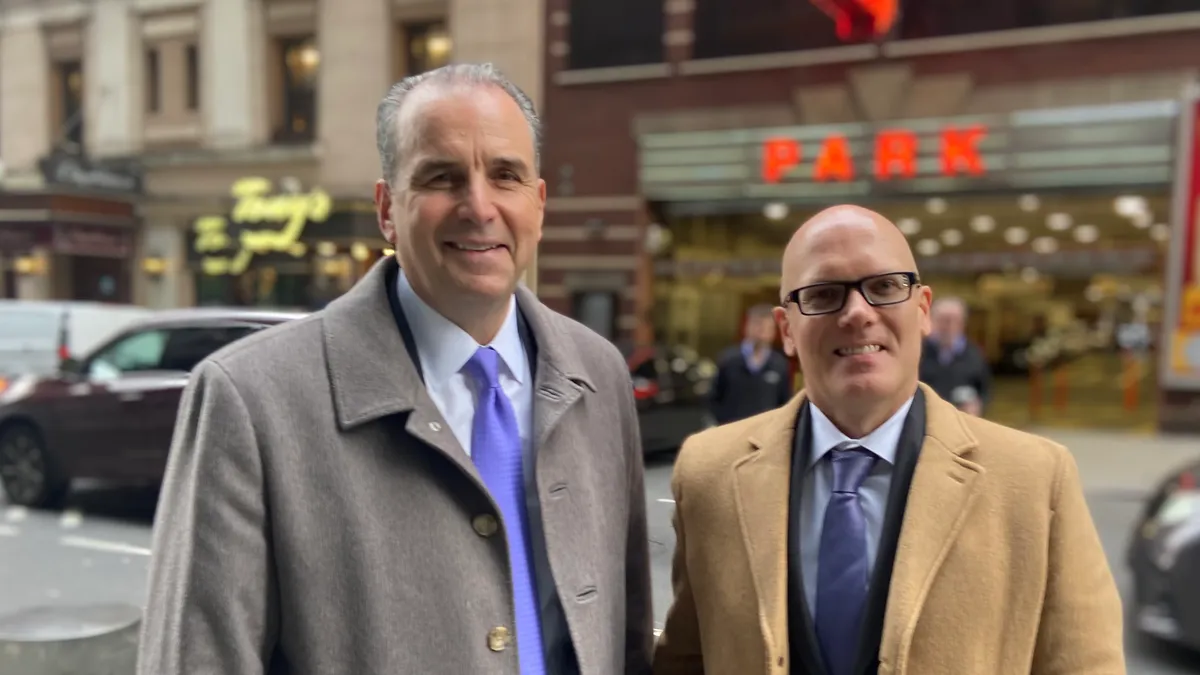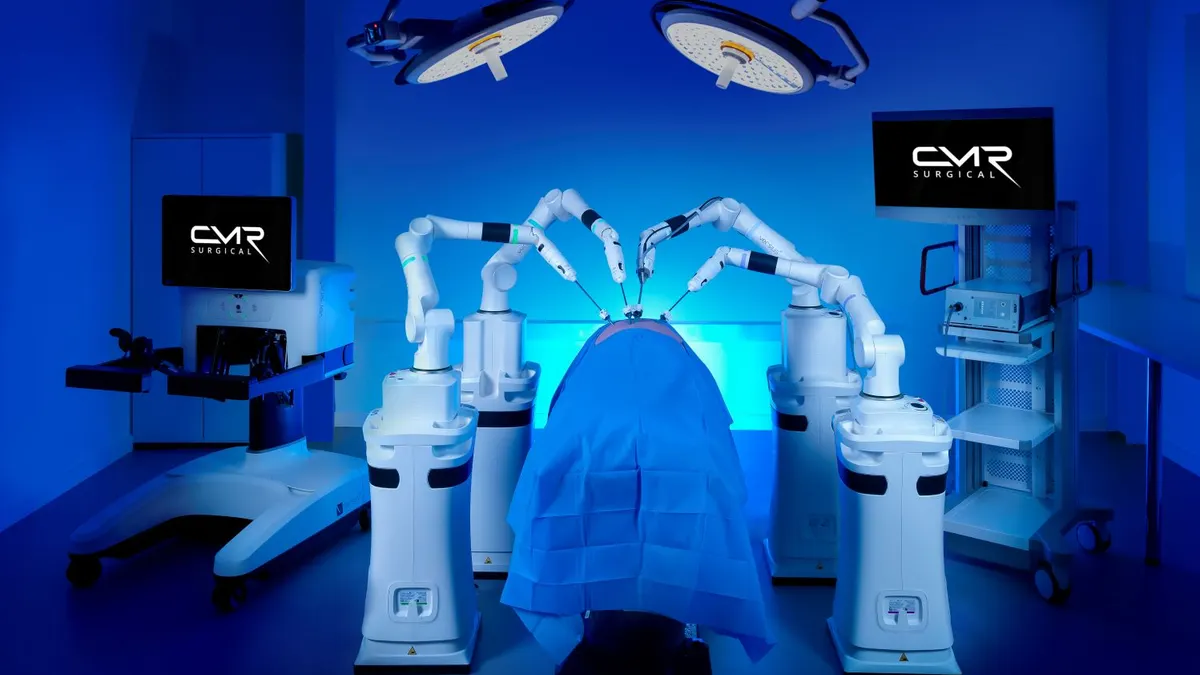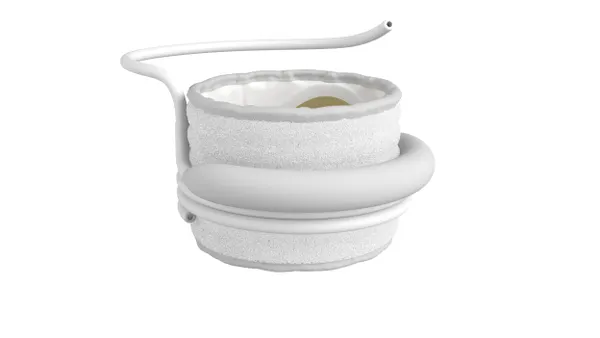As GE Healthcare prepares to go public as an independent company on Jan. 4, CEO Pete Arduini and CFO Helmut Zodl joined the rest of the firm’s top management to present the company’s future to analysts and investors in New York City. As a standalone firm, GE Healthcare forecasts compound annual growth rates of 3% to 7% across all its business sectors, an adjusted EBIT margin as high as 20% and increasing connectivity through its Edison AI platform.
This interview has been edited for length and clarity.
MedTech Dive: What's going to be different now that you're a standalone company?
PETE ARDUINI: The focus that we will bring by having our own balance sheet. We'll be able to invest in, I'd say, more apropos healthcare investments, that's a really important part. We've been a bit more of a giver in the past few years as part of GE, so to actually be able to put more into health technology, I think that's number one. Two, and this is part of how Helmut and I run the company, is just a more agile company. Decisions can take months, and I would say, the clock speed of the company, moving it from a focus on the quarter into focusing on the week, so we're well into that process. The other side is back to our core of innovation and investing at higher levels, and how we go to market and then also our digital capabilities, which are growing quite a bit.
The current economic situation for startups, with valuations plummeting and VCs running out of cash, seems to open up an opportunity for the big players like yourself.
ARDUINI: We have a lot of work to do, just coming out as a separate company here the first week of January and executing on our organic strategies. That being said, M&A has been and always will be an important part of the strategy. Whether it be collaborations, distribution agreements or actual acquisitions, I think you're going to see, particularly in the digital area. As those values change on [the] right assets out there, we're clearly going to be looking. Some of these take years to build the relationships. In my very first week, we started a weekly M&A [meeting]. Much of that is, hey, so there's Company X, that's an interesting area, we might want to partner to do something with them, who's got the relationship? How do we start building that relationship? And now we're starting to see fruits of that activity, which started years ago.
HELMUT ZODL: For us, it’s also having those four great platforms: imaging, ultrasound, patient care solutions and pharmaceutical diagnostics. So where something can fit in really nicely, it can plug in very quickly. That's something that we're quite excited about, because leveraging those platforms, it's quite unique for a player like us.
So you would be looking at acquisitions that slot into the Edison platforms?
ARDUINI: Yes, across the board. That's an enabler. A lot of times when companies are spun out, you know, it might be the black sheep of the family. We come out with a strong balance sheet, great credit rating, great products and already a running start. And that's important because the investment started a couple of years ago. And so now we're seeing the benefit of those products. We're actually seeing our growth rates increase. We've got pathways to the margin expansion. So it's not like you know, January 1, “Hey, what are you gonna do?” There has been a build up to this moment, which is one of the reasons we’re confident in what we can do.
What would Jack Welch say about this spinoff?
ARDUINI: Jack would probably start stuttering. But look, I think from a standpoint of the company and what we're doing, I think he would be very proud of the direction GE Healthcare is going, by itself and separate. We won't be able to ask Jack that, but I think what Jack was very good about was doing the things that are going to make a difference for customers and patients. And that's really at the core of what we're doing, and I think we can do it more effectively as a separate company.
Speaking of M&A and companies that have seen a massive decline in valuation, is Philips a target?
ARDUINI: We wouldn't comment about any companies, but you know, with the combinations of what we do in the marketplace, there's so many other areas and places that we would look at to go to grow.
You’ve laid out optimistic growth targets over the next three to five years in a high interest-rate environment, with hospital systems pressured to cut spending. How do you maintain high margins?
ZODL: The margin expansion is executed in three phases, Phase one is really about how we improve our commercial execution. We talked a lot about what's happening in pricing, and how can we get more productivity at a lower cost or on a certain path. [Last year and this year], we paid a significant amount of incremental costs, because parts availability was very challenging. Some of this will go away. Logistics is another key driver in offset, which has reduced already this year. [We are also] taking substantial actions on our cost structure: we took a restructuring in the third quarter, and we will really look very carefully where we have the opportunity to reduce costs. One of the biggest jobs that has already started is [to] look at our IT infrastructure coming from a $100 billion company, GE, to an $18 billion company, GE Healthcare. We have a great opportunity to improve and lower our costs in the infrastructures we have across the company.
Then I think it's all about how we can continue to grow the company. Mid-single-digit [sales] growth to get leverage will also be important.
The third piece is to be all about innovation. If you are first to market with a new innovation, if you're the one that really is pushing the envelope, whether it's on the device or the digital side, that's really what differentiates and you can demand a higher price and you can demand higher profitability. The more we bring this forward in those four businesses, we will continue to expand our margin as we go forward.
ARDUINI: Our customers have got big patient backlogs, people waiting to get exams and studies, so we're part of the solution to actually solving that for them. And in many cases, they're paying more for labor [and many] of our products allow them to get more done in that same high-cost labor window. So when they're saying, gee, I need to prioritize my spending, we typically come to the top of the list, because we're typically an enabler, and that gives us the volume for growth, and then you tie the items that Helmut tied to it, that's how we see the profit coming through.
Trying to recover from some of the COVID-era supply chain issues, what concrete steps are you taking to change that structurally?
ZODL: So dual sourcing, which we have, or multiple sourcing, because we operate a very large supply chain footprint: we have manufacturing in the US, in Europe, in Asia. So having really local suppliers for local manufacturing that either serves the local market or gets exported, that's very important for us.
ARDUINI: [We’ve talked] about platforming. And what platforming does relative to supply chain is, if you've got one product area that's got five different platforms, you're trying to find all those distinct parts to all these different scenarios, and in a challenged supply chain environment that's tough. If you're down to one or two platforms, with different iterations on it, you're worth a lot more to a given supplier, that's an important part of our variable cost reductions. We just got a lot smarter during the COVID window, I think, from how we've had global supply chains [to] not moving stuff around the world as much and having it more local, where it's consumed.
There's been a big growth in out-of-hospital services, ambulatory surgical centers and ambulatory care facilities. How do you see that shaping up versus the traditional hospital market?
ARDUINI: I think the core hospital market for the previous reasons about demand is still strong, but their outpatient volume is booming. This is a global phenomenon. Procedures that typically wanted surgical backup, because of COVID people started actually moving them out. And now they're sticking [with that], so full new knee replacements, hips, we make all the visualization equipment for that. So I think you're going to see that over the next three to five years continue to grow.
Are there changes that you would like to see for the industry in the way that devices are regulated both here and in Europe?
ARDUINI: So I would say, honestly, the FDA and what has taken place with Dr. [Jeffrey] Shuren [the director of the FDA’s Center for Devices and Radiological Health] who runs our world, he has actually done a pretty good job of moving stuff through at a reasonable clip. What's on the rise for us of concerns is, as you bring more artificial intelligence, and machine-based learning models that actually learn meaning, tomorrow, it's actually a slightly different product than it was yesterday, the current approval process with the FDA just doesn't know how to contemplate that, let alone CMS [the Centers for Medicare and Medicaid Services]. I think the rest of it, it's been pretty reasonable. To your point on EU MDR, you know, there were a lot of changes made that everybody needs to comply with. We're in actually quite good shape.
Would you be willing to pay more for better expertise in AI?
ARDUINI: That's a possibility. In the drug world, when you get a product approved by the agency, you automatically get [CMS billing] coding with it. That doesn't happen in the device world. There shouldn't have to be a second process to go through CMS to get coding. Should there be user fees or other methods to pay for it? I think it should be looked at, because we've always been the most innovative country in the world, and we want to have the most innovative companies. I'm hoping that our regulators take some of that into consideration.
Correction: Corrects date of GE Healthcare’s debut as a public company.





















